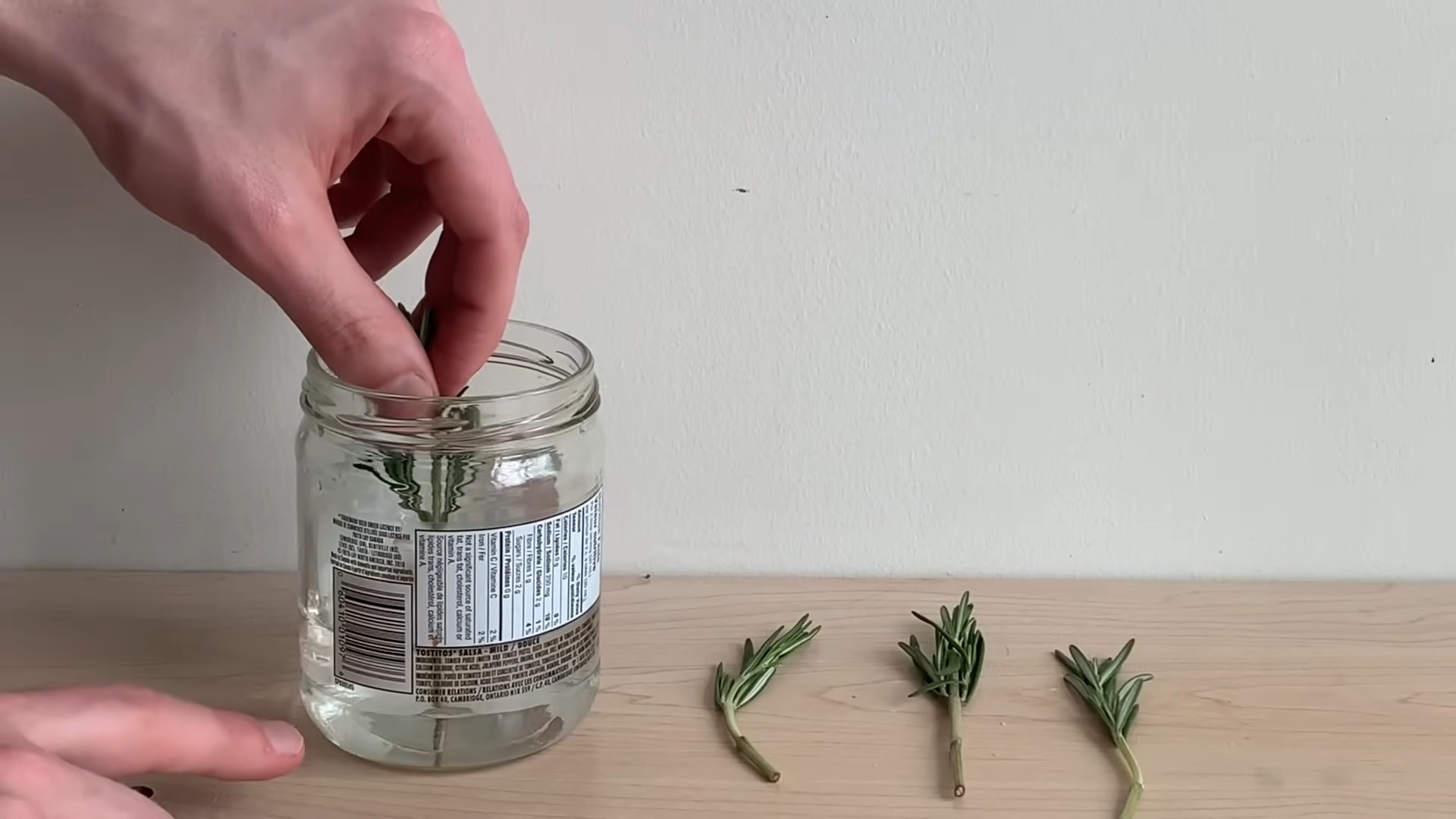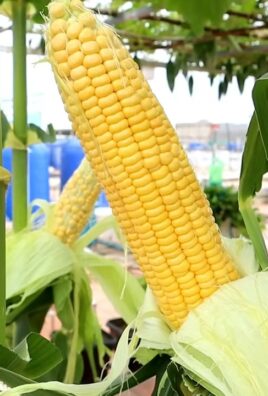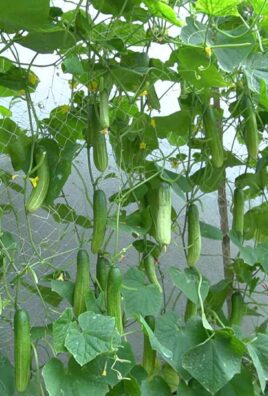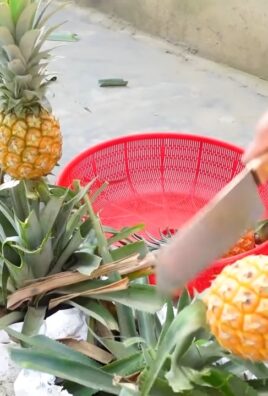Harvesting Rosemary from your own garden is one of the most rewarding experiences a home gardener can have! Imagine stepping outside, the sun warming your face, and snipping fresh, fragrant rosemary sprigs to elevate your next culinary masterpiece. But are you doing it right? Are you maximizing your rosemary plant’s potential? Don’t worry, I’m here to guide you through the process with some easy and effective DIY tricks.
Rosemary, with its needle-like leaves and woody aroma, has a rich history. For centuries, it’s been revered not only for its culinary uses but also for its medicinal and symbolic properties. Ancient Greeks and Romans associated rosemary with memory and remembrance, often wearing it in their hair or carrying it as a symbol of fidelity. Even today, rosemary is a popular herb in Mediterranean cuisine and is used in aromatherapy for its calming and invigorating effects.
Knowing how to properly harvest rosemary is crucial for both the health of your plant and the quality of your harvest. Improper harvesting can lead to stunted growth, disease, or a less flavorful herb. That’s why I’ve put together this guide filled with simple, yet effective, DIY tricks to ensure you’re harvesting rosemary like a pro. Whether you’re a seasoned gardener or just starting out, these tips will help you get the most out of your rosemary plant and enjoy its delightful flavor and fragrance all year round. Let’s get started!

Harvesting Rosemary Like a Pro: A DIY Guide
Okay, rosemary lovers, let’s talk about harvesting this fragrant herb! I’m going to walk you through everything you need to know to harvest rosemary from your garden (or even a pot on your balcony!) so you can enjoy its wonderful flavor and aroma all year round. Trust me, it’s easier than you think, and the fresh rosemary is SO much better than the dried stuff from the store.
When to Harvest Rosemary
Knowing when to harvest is key! You want to get the most flavor and ensure your plant stays healthy.
* Timing is Everything: The best time to harvest rosemary is in the morning, after the dew has dried but before the sun gets too hot. This is when the essential oils are most concentrated, giving you the best flavor.
* Mature Plants are Best: While you can technically harvest from a young plant, it’s best to wait until your rosemary plant is at least a year old. This gives it time to establish a strong root system and build up its reserves.
* Harvest Throughout the Season: Rosemary can be harvested throughout the growing season, from spring to fall. Just avoid heavy harvesting in late fall, as this can weaken the plant before winter.
* Flowering Rosemary: Don’t be afraid to harvest rosemary when it’s flowering! The flowers are edible and add a subtle sweetness to the flavor. In fact, some people believe that rosemary is at its most flavorful just before it blooms.
Tools You’ll Need
Gathering your tools beforehand will make the process smooth and efficient. Here’s what I recommend:
* Sharp Pruning Shears or Scissors: This is essential for making clean cuts and preventing damage to the plant. Dull tools can crush the stems and make them more susceptible to disease.
* Gloves (Optional): Rosemary isn’t prickly, but gloves can protect your hands from any dirt or sap.
* Basket or Bag: To collect your harvested rosemary sprigs.
* Rubber Bands or Twine: For bundling the rosemary for drying (if you plan to dry it).
* Water (Optional): A small bowl of water to keep the cut rosemary fresh while you’re harvesting.
Step-by-Step Harvesting Guide
Alright, let’s get down to the nitty-gritty! Here’s how I harvest my rosemary:
1. Inspect Your Plant: Before you start cutting, take a good look at your rosemary plant. Identify the stems you want to harvest. Look for healthy, vibrant green stems. Avoid any stems that are brown, woody, or show signs of disease.
2. Choose Your Stems: Select the stems you want to harvest. I usually aim for stems that are about 6-8 inches long. This gives me a good amount of rosemary to work with.
3. Make the Cut: Using your sharp pruning shears or scissors, make a clean cut just above a leaf node (where leaves grow out of the stem). Cutting above a leaf node encourages new growth from that point. I usually cut about 1/4 inch above the node.
4. Don’t Over-Harvest: It’s important not to take more than one-third of the plant at any one time. Over-harvesting can stress the plant and weaken it. Think of it like giving your rosemary a haircut – you want to trim it, not shave it!
5. Repeat as Needed: Continue selecting and cutting stems until you have the amount of rosemary you need. Remember to spread your cuts around the plant to maintain its shape and encourage even growth.
6. Rinse (Optional): If your rosemary is dusty or dirty, you can gently rinse it with cool water. Pat it dry with a clean towel.
7. Use Fresh or Preserve: Now you have a choice! You can use your fresh rosemary immediately in your cooking, or you can preserve it for later use. I’ll cover preserving methods in the next section.
Preserving Your Rosemary Harvest
So, you’ve got a beautiful bounty of rosemary. Now what? Here are a few ways I like to preserve my harvest:
Drying Rosemary
Drying is a classic and easy way to preserve rosemary.
1. Bundle the Rosemary: Gather the rosemary sprigs into small bundles (about 5-10 sprigs per bundle). Secure the bundles with rubber bands or twine.
2. Hang to Dry: Hang the bundles upside down in a cool, dark, and well-ventilated place. A pantry, closet, or attic works well. Make sure the bundles are not touching each other to allow for good air circulation.
3. Drying Time: It usually takes 1-3 weeks for the rosemary to dry completely. You’ll know it’s ready when the leaves are brittle and easily crumble.
4. Store the Dried Rosemary: Once the rosemary is dry, remove the leaves from the stems and store them in an airtight container in a cool, dark place. Dried rosemary can last for up to a year.
Freezing Rosemary
Freezing is another great option for preserving rosemary, especially if you want to retain its fresh flavor.
1. Prepare the Rosemary: Rinse the rosemary sprigs and pat them dry.
2. Flash Freeze (Optional): For best results, flash freeze the rosemary sprigs before storing them. To do this, spread the sprigs out on a baking sheet lined with parchment paper and freeze for about 2 hours, or until solid. This prevents the sprigs from clumping together when you store them.
3. Store in Freezer Bags: Transfer the rosemary sprigs to freezer bags or airtight containers. Remove as much air as possible before sealing.
4. Label and Freeze: Label the bags with the date and contents, and store them in the freezer. Frozen rosemary can last for up to 6 months.
Rosemary-Infused Oil
This is a fun and flavorful way to preserve rosemary and add a delicious touch to your cooking.
1. Prepare the Rosemary: Rinse the rosemary sprigs and pat them dry.
2. Sterilize a Jar: Sterilize a glass jar and lid by boiling them in water for 10 minutes. This will help prevent bacteria growth.
3. Combine Rosemary and Oil: Place the rosemary sprigs in the sterilized jar and cover them with a high-quality olive oil. Make sure the rosemary is completely submerged in the oil.
4. Infuse the Oil: Seal the jar and let it sit in a cool, dark place for at least 2 weeks to allow the rosemary flavor to infuse into the oil.
5. Strain (Optional): After 2 weeks, you can strain the oil to remove the rosemary sprigs, if desired. This will give you a clearer oil.
6. Store the Infused Oil: Store the rosemary-infused oil in a cool, dark place. It can last for several months.
Tips for Healthy Rosemary Growth
Harvesting is just one part of the equation. Here are some tips to keep your rosemary plant thriving:
* Sunlight is Key: Rosemary loves sunshine! Make sure your plant gets at least 6-8 hours of direct sunlight per day.
* Well-Draining Soil: Rosemary doesn’t like soggy roots. Plant it in well-draining soil to prevent root rot.
* Water Wisely: Water rosemary deeply but infrequently. Allow the soil to dry out slightly between waterings.
* Prune Regularly: Regular pruning encourages bushier growth and prevents the plant from becoming leggy.
* Fertilize Sparingly: Rosemary doesn’t need a lot of fertilizer. A light feeding in the spring is usually sufficient.
* Protect from Frost: Rosemary is relatively hardy, but it can be damaged by frost. If you live in a cold climate, consider bringing your rosemary plant indoors during the winter.
Using Your Rosemary Harvest
Now for the best part – using your freshly harvested or preserved rosemary! Here are just a few ideas:
* Roast Chicken or Lamb: Rosemary is a classic pairing with roasted meats.
* Potatoes: Add rosemary to roasted potatoes, mashed potatoes, or potato soup.
* Bread: Rosemary adds a wonderful flavor to homemade bread, focaccia, or pizza dough.
* Soups and Stews: Rosemary can be added to soups and stews for a warm, herbaceous flavor.
* Infused Oils and Vinegars: As mentioned earlier, rosemary-infused oil is delicious for drizzling over salads or vegetables. You can also infuse vinegar with rosemary for a flavorful salad dressing.
* Teas: Fresh or dried rosemary can be used to make a soothing and aromatic tea.
* Crafts: Dried rosemary can be used in potpourri, wreaths, or other crafts.
So there you have it! Everything you need to know to harvest and preserve rosemary like a pro. Happy harvesting! I hope you enjoy the wonderful flavor and aroma of your homegrown rosemary.

Conclusion
So, there you have it! Harvesting rosemary from your own garden, or even a potted plant on your windowsill, is not only incredibly simple but also deeply rewarding. It’s a must-try DIY trick for anyone who appreciates fresh, aromatic herbs in their cooking, home décor, or even homemade beauty products. Imagine the satisfaction of snipping off sprigs of fragrant rosemary to season your roasted chicken, infuse your olive oil, or create a soothing herbal tea – all from your own little patch of green.
The benefits extend far beyond just convenience. Freshly harvested rosemary boasts a more intense and vibrant flavor than its dried counterpart, elevating your culinary creations to a whole new level. Plus, you’re in complete control of the quality, ensuring that your rosemary is free from pesticides and other unwanted additives.
But the possibilities don’t stop there! Feel free to experiment with different rosemary varieties. Some have a more upright growth habit, while others trail beautifully, making them perfect for hanging baskets. You can also explore different harvesting techniques. For example, try drying your harvested rosemary by hanging it upside down in a cool, dark place for a few weeks. Once dried, you can crumble it and store it in an airtight container for later use. Another variation is to infuse rosemary into vinegar or honey for unique and flavorful additions to your pantry. Consider creating rosemary-infused bath salts for a relaxing and aromatic spa experience at home.
Don’t be intimidated by the process. Harvesting rosemary is forgiving and requires minimal effort. The plant is resilient and will continue to thrive with regular pruning. In fact, harvesting encourages new growth, resulting in a bushier and more productive plant.
We wholeheartedly encourage you to give this DIY trick a try. It’s a small investment of time that yields significant returns in flavor, freshness, and overall satisfaction. Once you experience the joy of harvesting your own rosemary, you’ll wonder why you didn’t start sooner.
And most importantly, we want to hear about your experience! Share your tips, tricks, and favorite ways to use your freshly harvested rosemary in the comments below. Did you try a particular variety? Did you discover a unique way to preserve your harvest? Your insights could inspire other readers and help them embark on their own rosemary harvesting journey. Let’s create a community of rosemary enthusiasts, sharing our knowledge and passion for this wonderful herb. So go ahead, grab your shears, and start harvesting! You won’t regret it.
Frequently Asked Questions (FAQ)
What is the best time of year to harvest rosemary?
The best time to harvest rosemary is generally in the late spring or early summer, after the plant has finished its initial flush of growth. However, you can harvest rosemary throughout the growing season as needed. Avoid heavy harvesting in the late fall, as this can weaken the plant before winter. The key is to harvest when the plant is actively growing and the essential oils are at their peak, resulting in the most flavorful and aromatic sprigs.
How do I know when my rosemary is ready to be harvested?
Rosemary is ready to be harvested when the stems are firm and the leaves are fully developed. The plant should be at least 8 inches tall before you begin harvesting. Look for healthy, vibrant green foliage. Avoid harvesting any stems that are woody or brown, as these will be less flavorful. A good rule of thumb is to harvest when the plant is actively growing and the new growth is abundant.
How much rosemary can I harvest at one time?
You can harvest up to one-third of the plant at a time without harming it. Avoid cutting back into the woody parts of the plant, as this can stunt its growth. Focus on harvesting the newer, greener growth. Regular harvesting actually encourages the plant to become bushier and more productive. If you need a larger quantity of rosemary, spread the harvesting out over several weeks.
What is the best way to harvest rosemary?
The best way to harvest rosemary is to use sharp, clean pruning shears or scissors. Cut the stems just above a leaf node (the point where leaves grow from the stem). This will encourage new growth from that point. Avoid tearing or ripping the stems, as this can damage the plant. Make clean, precise cuts for optimal healing and growth.
So, there you have it! Harvesting rosemary from your own garden, or even a potted plant on your windowsill, is not only incredibly simple but also deeply rewarding. It’s a must-try DIY trick for anyone who appreciates fresh, aromatic herbs in their cooking, home décor, or even homemade beauty products. Imagine the satisfaction of snipping off sprigs of fragrant rosemary to season your roasted chicken, infuse your olive oil, or create a soothing herbal tea – all from your own little patch of green.
The benefits extend far beyond just convenience. Freshly harvested rosemary boasts a more intense and vibrant flavor than its dried counterpart, elevating your culinary creations to a whole new level. Plus, you’re in complete control of the quality, ensuring that your rosemary is free from pesticides and other unwanted additives.
But the possibilities don’t stop there! Feel free to experiment with different rosemary varieties. Some have a more upright growth habit, while others trail beautifully, making them perfect for hanging baskets. You can also explore different harvesting techniques. For example, try drying your harvested rosemary by hanging it upside down in a cool, dark place for a few weeks. Once dried, you can crumble it and store it in an airtight container for later use. Another variation is to infuse rosemary into vinegar or honey for unique and flavorful additions to your pantry. Consider creating rosemary-infused bath salts for a relaxing and aromatic spa experience at home.
Don’t be intimidated by the process. Harvesting rosemary is forgiving and requires minimal effort. The plant is resilient and will continue to thrive with regular pruning. In fact, harvesting encourages new growth, resulting in a bushier and more productive plant.
We wholeheartedly encourage you to give this DIY trick a try. It’s a small investment of time that yields significant returns in flavor, freshness, and overall satisfaction. Once you experience the joy of harvesting your own rosemary, you’ll wonder why you didn’t start sooner.
And most importantly, we want to hear about your experience! Share your tips, tricks, and favorite ways to use your freshly harvested rosemary in the comments below. Did you try a particular variety? Did you discover a unique way to preserve your harvest? Your insights could inspire other readers and help them embark on their own rosemary harvesting journey. Let’s create a community of rosemary enthusiasts, sharing our knowledge and passion for this wonderful herb. So go ahead, grab your shears, and start harvesting! You won’t regret it.
Frequently Asked Questions (FAQ)
What is the best time of year to harvest rosemary?
The best time to harvest rosemary is generally in the late spring or early summer, after the plant has finished its initial flush of growth. However, you can harvest rosemary throughout the growing season as needed. Avoid heavy harvesting in the late fall, as this can weaken the plant before winter. The key is to harvest when the plant is actively growing and the essential oils are at their peak, resulting in the most flavorful and aromatic sprigs.
How do I know when my rosemary is ready to be harvested?
Rosemary is ready to be harvested when the stems are firm and the leaves are fully developed. The plant should be at least 8 inches tall before you begin harvesting. Look for healthy, vibrant green foliage. Avoid harvesting any stems that are woody or brown, as these will be less flavorful. A good rule of thumb is to harvest when the plant is actively growing and the new growth is abundant.
How much rosemary can I harvest at one time?
You can harvest up to one-third of the plant at a time without harming it. Avoid cutting back into the woody parts of the plant, as this can stunt its growth. Focus on harvesting the newer, greener growth. Regular harvesting actually encourages the plant to become bushier and more productive. If you need a larger quantity of rosemary, spread the harvesting out over several weeks.
What is the best way to harvest rosemary?
The best way to harvest rosemary is to use sharp, clean pruning shears or scissors. Cut the stems just above a leaf node (the point where leaves grow from the stem). This will encourage new growth from that point. Avoid tearing or ripping the stems, as this can damage the plant. Make clean, precise cuts for optimal healing and growth.
How should I store freshly harvested rosemary?
There are several ways to store freshly harvested rosemary. You can wrap the sprigs in a damp paper towel and store them in a plastic bag in the refrigerator for up to a week. Alternatively, you can stand the sprigs in a glass of water, like you would with cut flowers, and keep them in the refrigerator. For longer-term storage, you can dry the rosemary by hanging it upside down in a cool, dark, and well-ventilated place. Once dried, store the rosemary in an airtight container. You can also freeze rosemary sprigs in olive oil or water for later use.
Can I harvest rosemary from a potted plant?
Yes, you can absolutely harvest rosemary from a potted plant. In fact, growing rosemary in a pot is a great way to have fresh herbs readily available, even if you don’t have a garden. Follow the same harvesting guidelines as you would for rosemary grown in the ground. Ensure that your potted rosemary plant receives plenty of sunlight and well-draining soil.
My rosemary plant is getting woody. Can I still harvest from it?
While you can still harvest from a rosemary plant that is becoming woody, the flavor of the leaves on the woody stems may not be as intense. Focus on harvesting the newer, greener growth. You can also prune back the woody stems to encourage new growth. Regular pruning is essential for maintaining a healthy and productive rosemary plant.
How can I use my harvested rosemary?
The possibilities for using harvested rosemary are endless! You can use it fresh or dried in a variety of culinary dishes, such as roasted meats, vegetables, soups, and sauces. Rosemary also pairs well with olive oil, garlic, and lemon. You can infuse rosemary into olive oil or vinegar for a flavorful addition to your pantry. Rosemary can also be used in homemade beauty products, such as soaps, lotions, and hair rinses. Additionally, rosemary is a popular ingredient in aromatherapy and can be used to create calming and uplifting blends.
What are some common problems when growing rosemary and harvesting?
Some common problems when growing rosemary include root rot (caused by overwatering), powdery mildew, and pests such as aphids and spider mites. To prevent root rot, ensure that your rosemary plant is planted in well-draining soil and avoid overwatering. Powdery mildew can be treated with a fungicide. Pests can be controlled with insecticidal soap or neem oil. When harvesting, avoid damaging the plant by using sharp, clean tools and making precise cuts.
Is harvesting rosemary good for the plant?
Yes, harvesting rosemary is actually beneficial for the plant. Regular harvesting encourages new growth, resulting in a bushier and more productive plant. Pruning also helps to maintain the plant’s shape and prevent it from becoming too woody. By harvesting rosemary, you are essentially stimulating the plant to produce more foliage, which ultimately leads to a healthier and more vibrant plant.





Leave a Comment